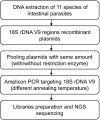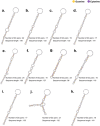Optimization of 18 S rRNA metabarcoding for the simultaneous diagnosis of intestinal parasites
- PMID: 39443558
- PMCID: PMC11499679
- DOI: 10.1038/s41598-024-76304-1
Optimization of 18 S rRNA metabarcoding for the simultaneous diagnosis of intestinal parasites
Abstract
Recent advancements in next-generation sequencing (NGS) technologies have created new opportunities for comprehensive screening of multiple parasite species. In this study, we cloned the 18 S rDNA V9 region of 11 species of intestinal parasites into plasmids. Equal amounts and concentrations of these 11 plasmids were pooled, and amplicon NGS targeting the 18 S rDNA V9 region was performed using the Illumina iSeq 100 platform. A total of 434,849 reads were identified, and all 11 parasite species were detected, although the number of output reads for each parasite varied. The read count ratio, in descending order, was as follows: Clonorchis sinensis, 17.2%; Entamoeba histolytica, 16.7%; Dibothriocephalus latus, 14.4%; Trichuris trichiura, 10.8%; Fasciola hepatica, 8.7%; Necator americanus, 8.5%; Paragonimus westermani, 8.5%; Taenia saginata, 7.1%; Giardia intestinalis, 5.0%; Ascaris lumbricoides, 1.7%; and Enterobius vermicularis, 0.9%. We found that the DNA secondary structures showed a negative association with the number of output reads. Additionally, variations in the amplicon PCR annealing temperature affected the relative abundance of output reads for each parasite. These findings can be applied to improve parasite detection methodologies and ultimately enhance efforts to control and prevent intestinal parasitic infections.
Keywords: 18S rDNA; Helminths; Intestinal parasites; Metabarcoding; Next generation sequencing; Protozoa.
© 2024. The Author(s).
Conflict of interest statement
The authors declare no competing interests.
Figures





Similar articles
-
Diagnosis of intestinal parasites in a rural community of Venezuela: Advantages and disadvantages of using microscopy or RT-PCR.Acta Trop. 2017 Mar;167:64-70. doi: 10.1016/j.actatropica.2016.12.014. Epub 2016 Dec 19. Acta Trop. 2017. PMID: 28007484
-
Comparison of commercial and in-house real-time PCR platforms for 15 parasites and microsporidia in human stool samples without a gold standard.Acta Trop. 2020 Jul;207:105516. doi: 10.1016/j.actatropica.2020.105516. Epub 2020 May 3. Acta Trop. 2020. PMID: 32371221
-
The Distribution of Pathogenic Intestinal Parasites in Sivas Cumhuriyet University Faculty of Medicine Research and Application Hospital between 2006-2018.Turkiye Parazitol Derg. 2020 Mar 20;44(1):25-30. doi: 10.4274/tpd.galenos.2020.6619. Turkiye Parazitol Derg. 2020. PMID: 32212586
-
Parasites in surgically removed appendices as a neglected public health concern: a systematic review and meta-analysis.Pathog Glob Health. 2022 Sep;116(6):341-355. doi: 10.1080/20477724.2021.2008701. Epub 2021 Nov 27. Pathog Glob Health. 2022. PMID: 34842078 Free PMC article.
-
Human intestinal parasites in the past: new findings and a review.Mem Inst Oswaldo Cruz. 2003;98 Suppl 1:103-18. doi: 10.1590/s0074-02762003000900016. Mem Inst Oswaldo Cruz. 2003. PMID: 12687769 Review.
Cited by
-
Nationwide investigation of eukaryotic pathogens in ticks from cattle and sheep in Kyrgyzstan using metabarcoding.PLoS One. 2025 Aug 5;20(8):e0327953. doi: 10.1371/journal.pone.0327953. eCollection 2025. PLoS One. 2025. PMID: 40763172 Free PMC article.
-
Identification of Clonorchis sinensis in bronchoalveolar lavage fluid and peripheral blood using next-generation sequencing in a patient with septic shock: a case report and literature review.Emerg Microbes Infect. 2025 Dec;14(1):2511133. doi: 10.1080/22221751.2025.2511133. Epub 2025 Jun 3. Emerg Microbes Infect. 2025. PMID: 40407725 Free PMC article. Review.
References
-
- World Health Organization (WHO). Soil-Transmitted Helminth Infections. (2023). https://www.who.int/news-room/fact-sheets/detail/soil-transmitted-helmin... Accessed 18 January 2023.
MeSH terms
Substances
Grants and funding
LinkOut - more resources
Full Text Sources

